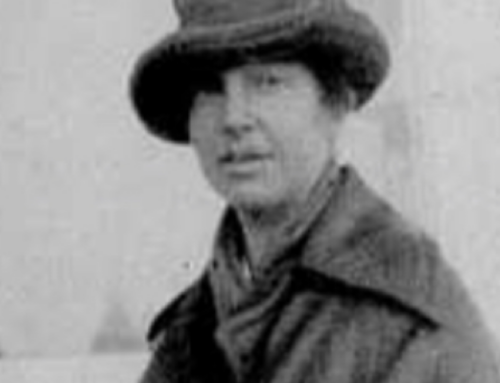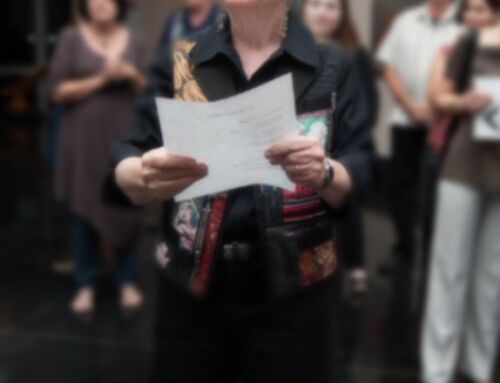NAWA Luminaries – Berta N. Briggs, painter and writer
Nawa Luminaries is the intersection of NAWA’s Historical Research and current events around the United States highlighting celebrated NAWA members.
We each have our origin story, the account or backstory revealing how a person or group became who they are. It shows how one started, what one went through, and why it matters. NAWA’s origin story, five women artists getting together on the evening of January 31, 1889, intent on organizing an association of serious women artists, is the result of research conducted by Berta N. Briggs. Briggs, a Past President of NAWA (1930-1932), joined the Association in 1928 when it was called the National Association of Women Painters and Sculptors.

The Good Listener, 1942 Annual National Association of Women Painters and Sculptors Exhibition.
Berta N. Briggs was born in St. Paul, Minnesota, on June 5, 1884, the daughter of John William and Rosina (Reinfrank) Nabersberg. After she graduated from Central High School, Berta moved to New York City, studying at the Art Students League under Kenyon Cox, Pratt Institute in Brooklyn with Ralph Johonnot, and Teachers College, Columbia University, under Arthur W. Dow. Berta returned to St. Paul in 1905, where she was appointed the first Supervisor of Handicrafts for the 52 public schools, a position she held for three years. From 1908-1911, she organized and directed the Department of Crafts at the St. Paul Institute School, where she taught pottery, metalwork, leatherwork, textile design, and woodblock printing. Berta enjoyed summers at the Minneapolis Handicraft Guild, working with Ernest Batchelder and Berta Lum.
When Berta moved to New York in 1911, she became the head of the art department at Charlton School, a private school for girls, teaching art and lecturing on the history of art and architecture. On June 18, 1913, she married William H. Briggs, writer, playwright, and editor for Harper and Brothers. From 1918 to 1928, Berta lectured on the history of art at Miss Chandor’s School, and with nine other craft workers, she founded an outlet for craftwork, the Noank Studio Guild. There was a shift in her focus beginning in 1928 when Berta started to paint professionally, focusing on landscapes and images of birds. She observed the birds, drawn from life, in the Bronx Zoo, but they were often stylized and referenced caricatures of humans. Berta joined the National Association of Women Painters and Sculptors in 1928 and quickly became a board member, serving as Corresponding Secretary. She was the Association’s Vice President from 1929-30 and President from 1930 to 1932. In the 1930 Annual Exhibition catalog, Briggs described the recent sale of the Association’s headquarters on East 62nd Street and their new location, the Argent Gallery.
Her letter to the membership noted:
For forty years, the Association has stimulated the work of women artists throughout the country by giving them an opportunity to show their work in New York under dignified auspices, and by maintaining a high standard for membership qualification, it has encouraged their best efforts. The Association has never asked that the work of its members be judged on the basis of chivalry towards women, but solely on the intrinsic and artistic merit of the work itself.
It was her explicit hope that success in the new headquarters would carry the Association forward to building their own “where clubrooms and studios, as well as gallery facilities,” would be provided for the members of the Association. She exhibited four works of art that year.
In 1935, having once again served as Vice President from 1932-1933, Berta wrote an essay describing the Association for the Annual Exhibition catalog and included incidents in the organization’s history. The essay was included in subsequent annual exhibition catalogs. In 1939, with Elizabeth Caddy Stanton Blake now President, Briggs was entrusted with writing the history of the Association’s first fifty years. Many of the records had been lost. Berta had to piece together her narrative from all available sources, emphasizing high points as she gave what Stanton referred to in her Foreword as “meaning and vitality to the whole picture –a past we can be proud to contemplate.” To this end, Berta noted:
“All that has been accomplished throughout the years is due to the volunteer work of the members, given at the sacrifice of personal interests and often in the face of heavy odds. This spirit of unselfish idealism has given the organization a vitality which has carried it through difficulties which would have wrecked most societies.”
The History of the National Association of Women Painters and Sculptors, 1889—1939, ten pages in length and first published in the 1939 catalog, would form the origin story cited in NAWA’s Centennial celebration in 1989, written by Ronald G. Pisano, where Berta N. Briggs was mentioned in a footnote.
Berta served as Vice-President and Chairperson of the Society of Woman Geographers from 1939 to 1942 and as a trustee and president of the School Art League of New York. In addition to five exhibitions of her work in New York City, her paintings were displayed throughout the United States and in London. In 1952, McGraw-Hill Book Company published Berta’s Charles Wilson Peale, Artist, and Patriot, and a favorable review by the noted painter, author, and art historian Alan Burroughs appeared in the January 1953 issue of The William and Mary Quarterly (pp.138-139). Burroughs, clearly impressed by the biography, noted:
This compact version of Peale’s wonderful life gives an even more intimate effect than Charles Coleman Seller’s exhaustive two-volume account….It is not a condensation of Seller’s historical work, but a reworking of the original Peale papers, and includes personal touches which seem to have not yet appeared in print….It is a sensitive record, and the critic who points out one mental slip…does so only because he wishes to indicate that he read and appreciated every page of it.
Arguably a trailblazer in what would be known as the New Journalism Movement of the 1960s, Berta’s intimate biographical narrative, with a bent for visual thinking, would evolve into the contemporary genre known as narrative nonfiction.
Berta’s husband, William Briggs, died in 1953 after working for Harper and Brothers for 44 years. Berta continued writing, authoring To the Shores of Tripoli, a story of Babary pirates published in 1955. When Briggs offered her written resignation from the National Association in 1957, she was no longer painting or exhibiting, and the dues were a financial burden. The Board acted immediately and made her an Honorary Life member. Briggs died in New York on November 12, 1976.
As we celebrate the first 135 years of NAWA, the Historical Research Team is taking a meaningful look back at the exemplary women upon whose shoulders we stand. We are grateful for their sacrifices and the inspiration they continue to provide.
Resources:
Thanks to the Smithsonian Archives of American Art for biographical information
(https://www.aaa.si.edu/collections/berta-n-briggs-papers-6827/biographical-note).
Special thanks to Kate Van Riper, Archivist for Women Artists’ Collections at Rutgers University Libraries, for her generous help accessing NAWA’s archived papers.
Susan M. Rostan, M.F.A , Ed.D. Co-Leader: NAWA Historical Research Team. Website.
Signature Member of the National Association of Women Artists
NAWA. Empowering Women Artists Since 1889







































